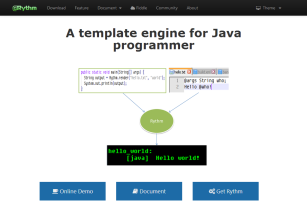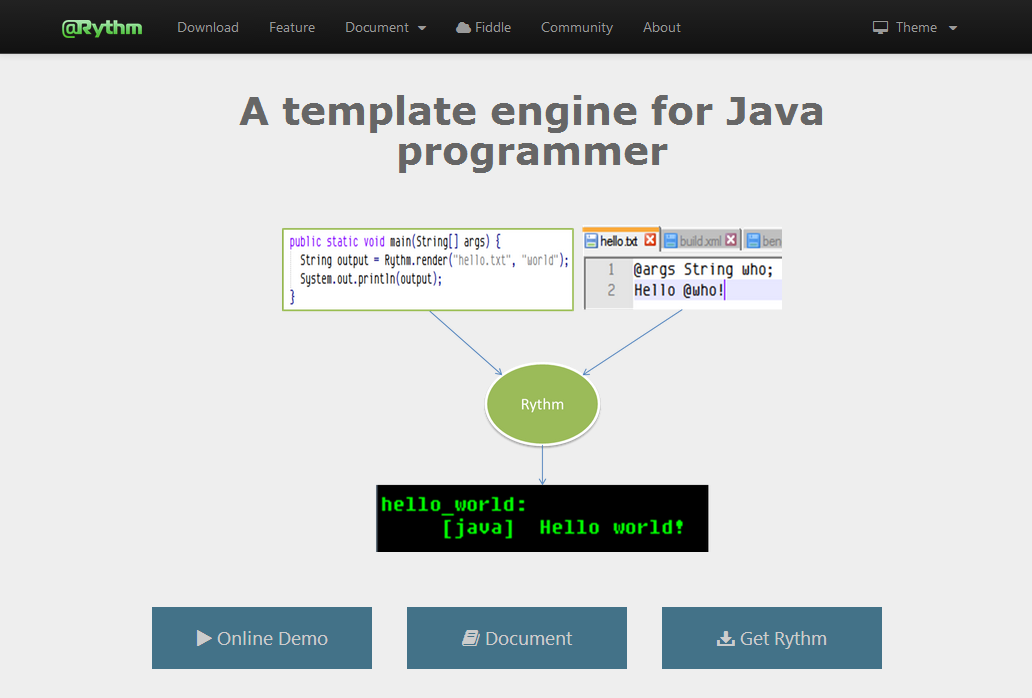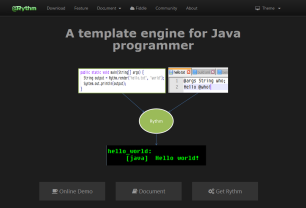Tutorial
[evn]Setup your environment
You need to setup your environment properly to follow this tutorial step by step. Please make you have the following software installed on your machine:
Java, JRE or JDK 1.6+

Ant 1.7+

Maven 2 or Maven 3

Rythm. Please follow the document guide to download latest Rythm distribution package
and unzip to a local folder, e.g.C:\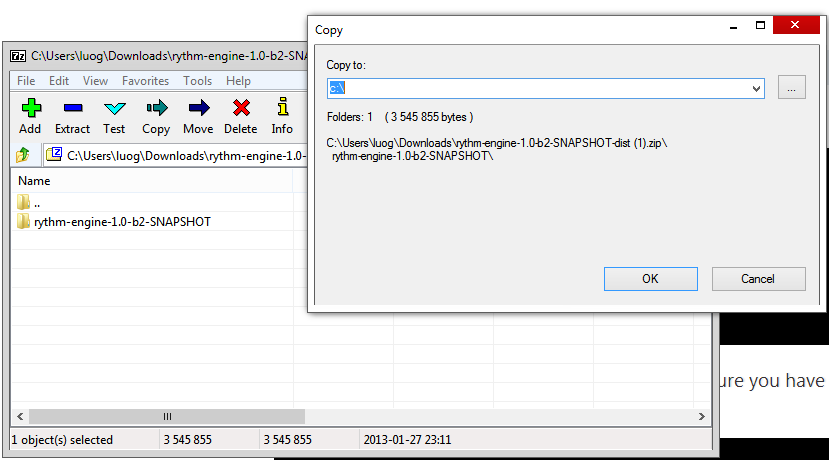
[hello] Hello world!
As our first step in the journey, let's first get our feet wet and say “Hello world!” using Rythm.
Create a project folder named “HelloWorld”, and create a
srcfolder under it: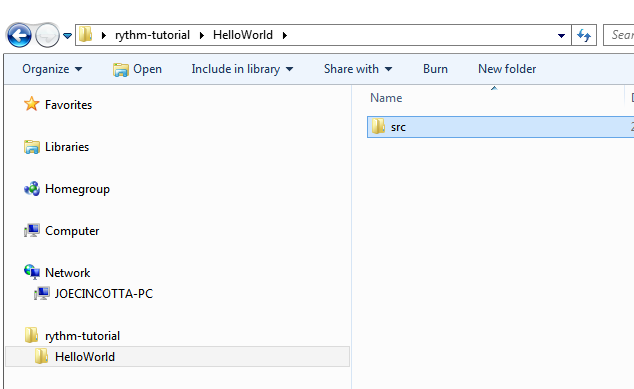
Add an ant
build.xmlfile toHelloWorldproject: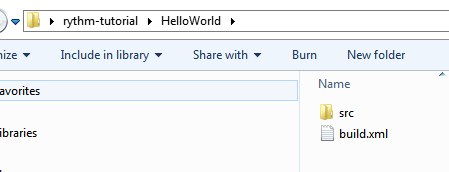
And copy the content from the github version to your
build.xmlfileAdd a
build.propertiesfile toHelloWorldproject: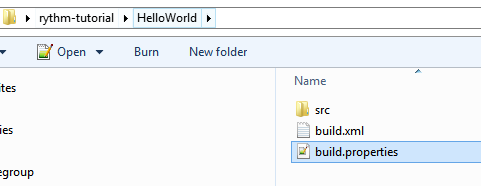
Put the following lines to the
build.propertiesfile:src=src lib=lib classes=classes # change this line to make it point to your rythm folder rythm.home=c:\\rythm-engine-1.0-b9-SNAPSHOT rythm.lib=${rythm.home}/libCreate the
HelloWorld.javasource file in thesrcfolder: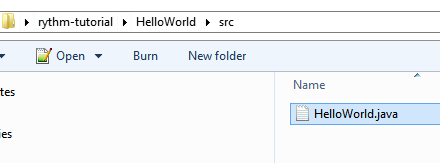
Add the following lines to your first Rythm program:
import org.rythmengine.Rythm; public class HelloWorld { public static void main(String[] args) { System.out.println(Rythm.render("hello @who!", "rythm")); } }Now we are ready, and let's run it:
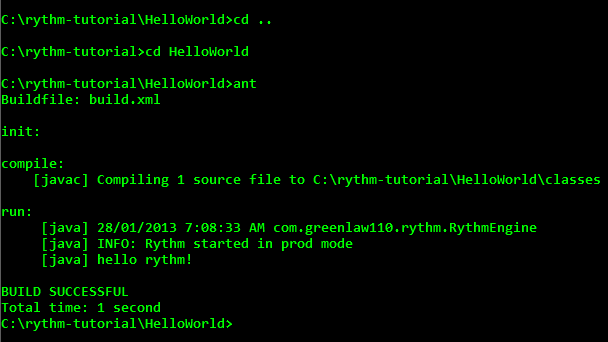
All good, we got the result! But wait, it's
hello rythm!, not theHello World!as we expected. Let's go back to our program and do a bit changes fromSystem.out.println(Rythm.render("hello @who!", "rythm"));to
System.out.println(Rythm.render("Hello @who!", "World"));and then run again:
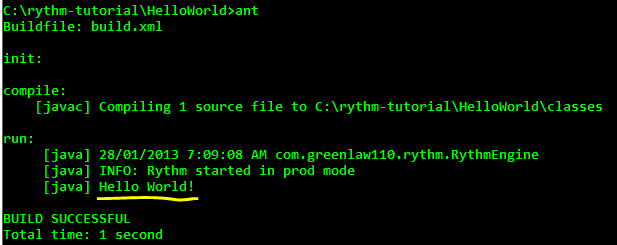
Yes! we made it!
Now let's change the inline template content into a template file. To make it a bit more fancy, we create it as a web page instead of a plain text file. Following standard Java project convention, we will create the file in a
resourcesfolder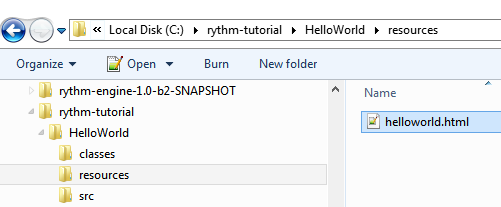
and add some content into the
helloworld.htmlfile:@args String who <html> <head> <title>Hello world from Rythm</title> </head> <body> <h1>Hello @who</h1> </body> </html>And we have to change our program to make it render an external template file instead of an inline template content. Let change the line from
System.out.println(Rythm.render("Hello @who!", "World"));to
System.out.println(Rythm.render("helloworld.html", "World"));And run the program again and see what we get:
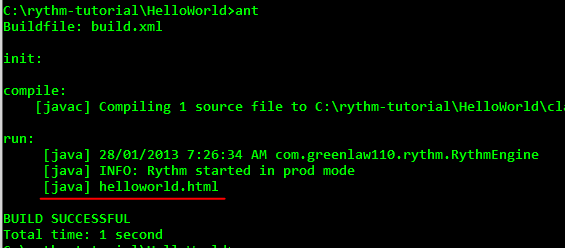
Oh no, this isn't what we want! What happened?
Okay here is what's going on: Rythm take “helloworld.html” as a template content rather than an external filename because Rythm cannot find a file named
helloworld.html. We need to tell Rythm where the template file is. There are 2 ways to tell Rythm where to load an external file:- Set the
home.templateproperty to let Rythm know where the template files are stored. This must be done before calling Rythm to render anything - Put the template file into Java's class path
Let's try
home.templateapproach first. Change theHelloWorld.javafile as the follows:import java.util.*; import org.rythmengine.Rythm; public class HelloWorld { public static void main(String[] args) { // use Map to store the configuration Map<String, Object> map = new HashMap<String, Object>(); // tell rythm where to find the template files map.put("home.template", "resources"); // init Rythm with our predefined configuration Rythm.init(map); System.out.println(Rythm.render("helloworld.html", "World")); } }And run again:
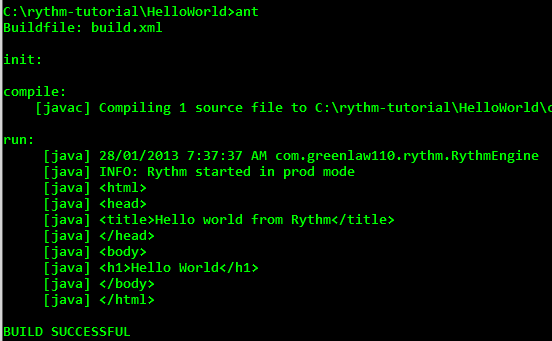
Now it comes out what we wanted.
Next step let's try the class path approach. First revert the
HelloWorld.javaprogram back to what is previously by commenting out thosehome.templateconfiguration lines:import java.util.*; import org.rythmengine.Rythm; public class HelloWorld { public static void main(String[] args) { // use Map to store the configuration //Map<String, Object> map = new HashMap<String, Object>(); // tell rythm where to find the template files //map.put("home.template", "resources"); // init Rythm with our predefined configuration //Rythm.init(map); System.out.println(Rythm.render("helloworld.html", "World")); } }And do a bit changes in our
build.xmlfile under the HelloWorld project root folder. What we want to do is to tell ant we need to copy thehelloworld.htmlfile from theresourcesfolder to theclassesfolder before running the program. Let's add the following line<copy file="resources/helloworld.html" todir="${classes}"/>to the
inittarget in thebuild.xmlfile, right above the closing</target>tag. After you have finished theinittarget should looks like the follows:<target name="init"> <tstamp/> <mkdir dir="${classes}"/> <copy file="resources/helloworld.html" todir="${classes}"/> </target>And then run the program again, you should get the same result as previous.
To summarize what we have learned from
HelloWorldproject so far- Calling to
Rythm.render()will cause Rythm to process a template with a supplied parameter and return the result - template is passed into
Rythm.renderas the first parameter, it could be either an inline template content (Hello @who!), or an external template file name (helloworld.html) - the template argument is passed into
Rythm.render()following the template parameter (the first parameter)
Now let's put a little challenge to our
HelloWorldproject. We want the template not only say “Hello”, but also be able to say “Greeting” depend on user's input. First change the following line in ourhelloworld.htmltemplate file:@args String who ... <h1>Hello @who</h1>to
@args String action, String who ... <h1>@action @who</h1>Meaning we don't hard code “Hello” in our template, rather, we add a template argument
@actionso user can change the output of the template by passing different@actionto the template.Then go to the Java file and add one more parameter to the render line of
HelloWorld.javaprogram so it changed from:System.out.println(Rythm.render("helloworld.html", "World"));to
System.out.println(Rythm.render("helloworld.html", "World", "Greeting"));Run the program we get
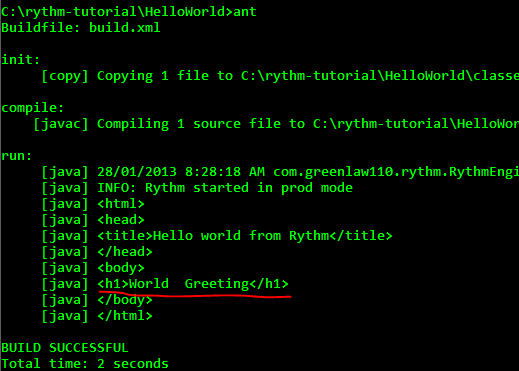
See there is a problem in the result, we want to say “Greeting World” and it becomes “World Greeting”, this is because the argument
@actionis declared before the argument@whoin the template source. So just swap the “World” and “Greeting” in theHelloWorld.javawill fix the problem.In case a template has a lot of arguments we want to use the argument name instead of position to pass the parameters. Rythm support passing template arguments by name. Here is the new
HelloWorld.java:import java.util.*; import org.rythmengine.Rythm; public class HelloWorld { public static void main(String[] args) { Map<String, Object> params = new HashMap<String, Object>(2); params.put("who", "World"); params.put("action", "Greeting"); System.out.println(Rythm.render("helloworld.html", params)); } }After you putting the new version to your
HelloWorld.javafile, run the program again. This time we got the correct output: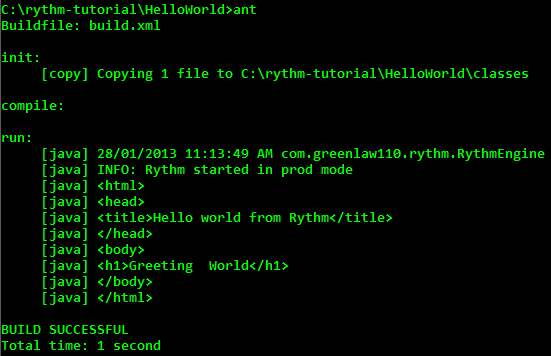
For people who think populating a
Mapdata structure is boring, Rythm provides a utility classNamedParameterto make it easier:import java.util.*; import org.rythmengine.Rythm; import org.rythmengine.utils.*; public class HelloWorld { public static void main(String[] args) { NamedParams np = NamedParams.instance; System.out.println( Rythm.render("helloworld.html", np.from( np.pair("who", "World"), np.pair("action", "Greeting")))); } }Before we wrap up our
HelloWorldproject, we want to touch a bit more about Rythm's special@character. Let's suppose the user design a template where he put an email address inside. As we know all email address contains the@character. What will happen if we update our template and add an email address like the follows:@args String who, String action <html> <head> <title>Hello world from Rythm</title> </head> <body> <h1>@action @who</h1> <p>Please contact me at green@rythmengine.com</p> </body> </html>Run the program we get this:
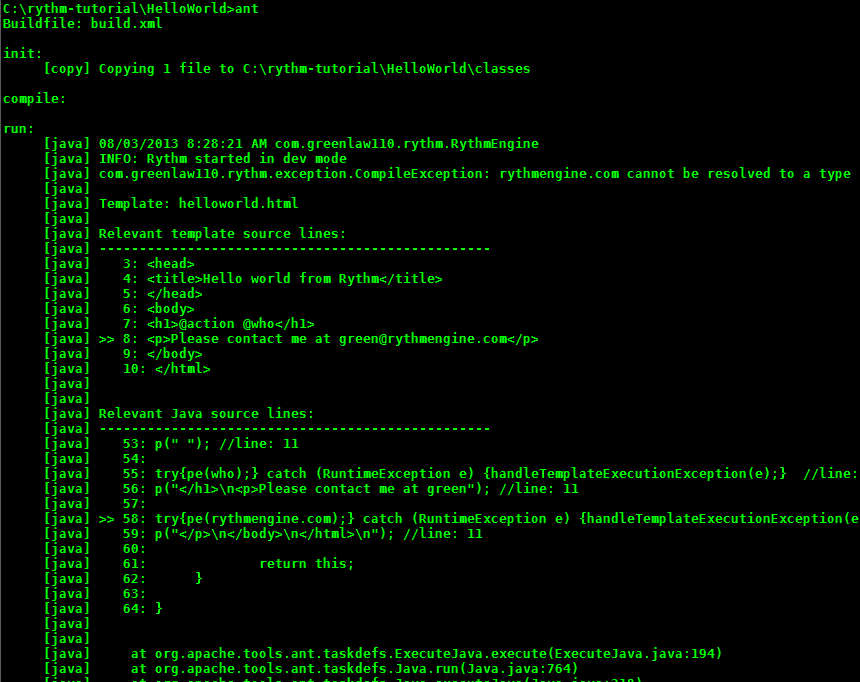
So Rythm complaining
rythmengine.com cannot be resolved to a type, obviously it treat the email host as an expression. Ths solution is to put one additional@to@rythmengine.com, so the email address in a template changes togreen@@rythmengine.com. Double@tell rythm that this is not the special character to lead a syntax element, but rather a literal@sign. When you finish changing the template source run the program again and it shows the good result: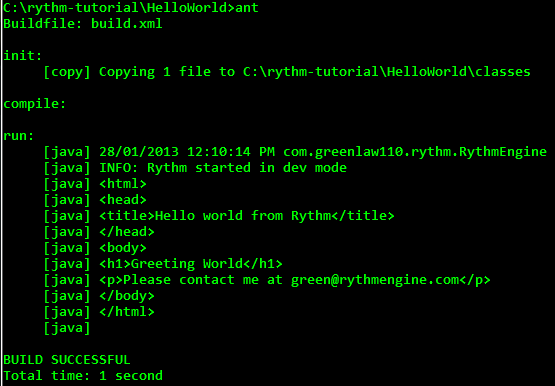
Alright I think it is enough for us to wrap up the
HelloWorldproject. We have learned a lot of things about Rythm though this tiny project:- Calling to
Rythm.render()will cause Rythm to process a template with a supplied parameter and return the result - template is passed into
Rythm.renderas the first parameter, it could be either an inline template content (Hello @who!), or an external template file name (helloworld.html) - the template argument is passed into
Rythm.render()following the template parameter (the first parameter) Rythm.render()accept passing template parameters by position or by name. UseMap<String, Object>to pass the parameters by name- If you need to show the special
@sign in the template directly, double it.
For the next step we are going to do something serious!
- Set the
[bookstore]Duke's bookstore
Duke's bookstore is coming soon. Stay tuned!

